OpenID Connect (OIDC) Integration
OpenID Connect (OIDC) integrates with Identity Providers (IdP) external to QuestDB.
It is a convenient way to integrate QuestDB into your enterprise environment, and it provides SSO (Single Sign-On) for the Web Console.
Microsoft Active Directory and Azure AD, for example, can be turned into an Identity Provider.
Specific installation steps depend on the type of the provider.
OpenID Connect (OIDC) is only available in QuestDB Enterprise.
Architecture overview
Altogether, the architecture appears as such:

We can break it down into core components.
Web Console
QuestDB's interactive UI. Users must authenticate before accessing the database via the interface.
The Web Console uses PKCE (Proof Key for Code Exchange) to secure the authentication and authorization flow.
In OAuth2/OIDC terms, the Web Console is referred to as the client, and it is assigned an identifier: the Client Id.
Each application which integrates via OIDC should be given a different Client Id.
OIDC Provider
Typically consists of a number of modules.
We are interested in two of them only.
-
The Identity Provider holds user identities and user information, capable of authenticating users, and to issue an ID Token which uniquely identify them.
-
The Authorization Server grants access to resources, such as a database, in the form of access tokens.
The OIDC Provider usually integrates with a number of applications which require different access to a number of resources.
These clients communicate with the OIDC Provider via its endpoints.
It exposes a number of APIs, including the Authorization, Token and User Info endpoints.
QuestDB
The database, in OAuth2/OIDC terms the protected resource or resource server.
Only processes requests which contain a valid access token.
Authentication and Authorization Flow
The OAuth2/OIDC standard defines different ways of obtaining access and ID tokens from the OIDC Provider, referred to as the "flow".
The goal of this flow is to get the user, who is sitting in front of the Web Console, authenticated.
Then, it allows QuestDB to determine the user's permissions based on user information provided by the Identity Providers.
Specifically, the QuestDB Web Console uses the
Authorization Code Flow with PKCE option.
It consists of ten steps...
1. Secret generation
First the Web Console generates a cryptographically strong random secret called the code verifier.
The secret is hashed using the SHA256 algorithm. The result is the code challenge.
After PKCE initialization the Web Console requests an authorization code from the OIDC Provider.
It calls the Authorization endpoint with a few parameters, including the:
- Client Id
- requested scopes (the list of scopes are configurable, default is
openidonly) - code challenge
- algorithm used to generate the code challenge from the code verifier (SHA256)
When the Authorization Server receives the request, it checks if the user has been authenticated already:
-
If the user has a valid session, it can be provided with an authorization code straight away, so we jump to step 4.
-
If the user does not have a valid session yet, it will be redirected to the Identity Provider for authentication.
https://oidc.provider:443/as/authorization.oauth2?client_id=questdb&response_type=code&scope=openid&redirect_uri=https%3A%2F%2Fquestdb.host%3A9000&code_challenge=IwZ-WuypAY3fMtvismbj1MQUe5CzMgrBa87nYcgFoLQ&code_challenge_method=S256
2. Prove identity
Next, the user must prove its identity.
This could be a username with:
- a password,
- an OTP
- facial recognition via a mobile app
- or anything else supported by the Identity Provider.
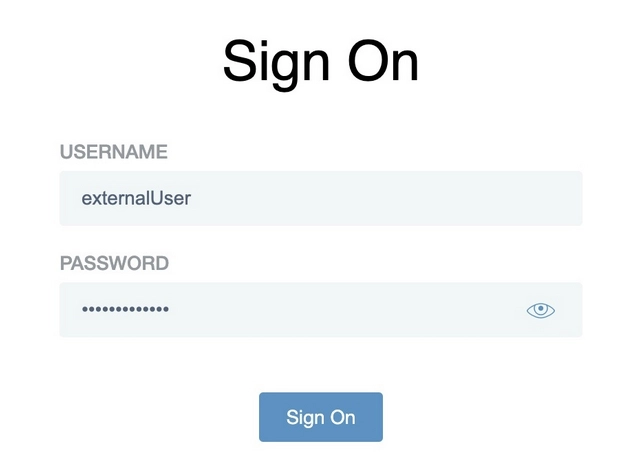
3. Scope consent
After successful authentication, the user provides consent for the requested scopes.
The list of scopes are configurable.
By default the Web Console requests only the openid scope which is mandatory
for OIDC.
No ID Token is issued without it.
The OIDC provider can be configured to provide the consent automatically, without presenting the user with an additional screen in the browser.
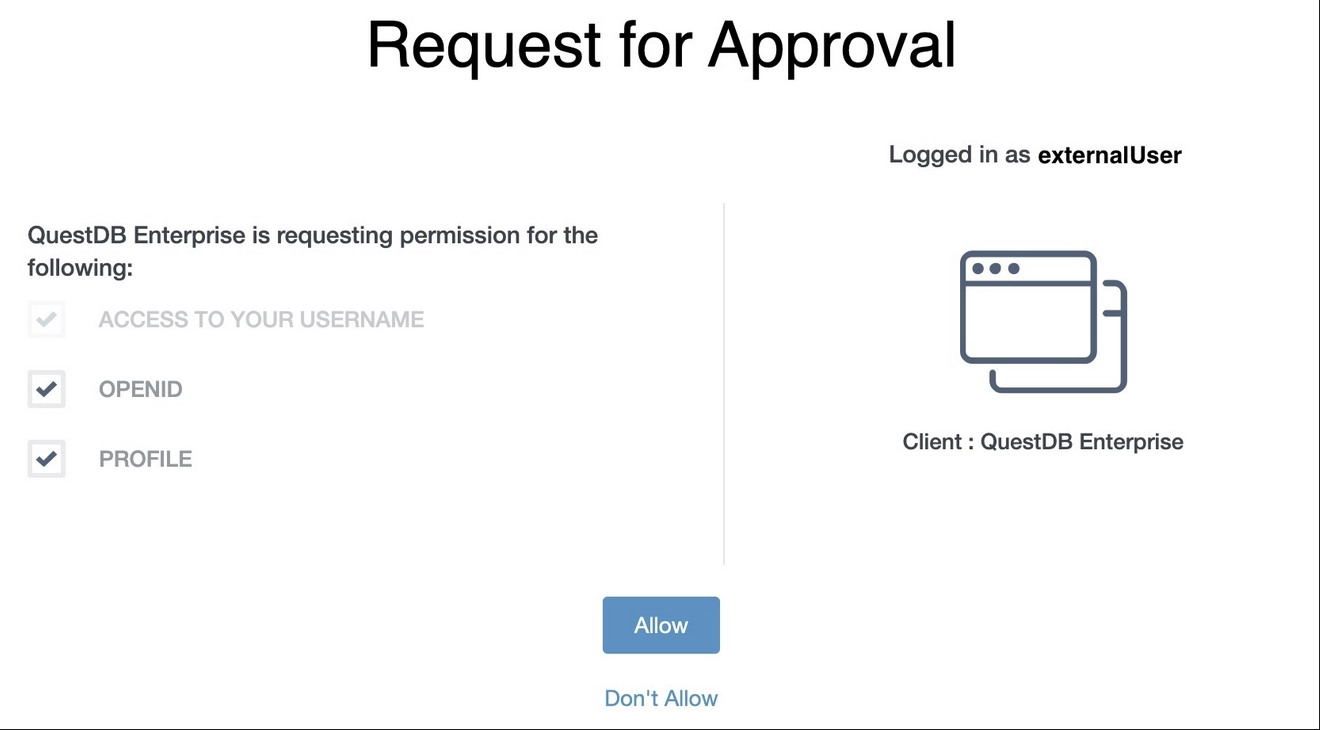
4. Redirection
Consent is granted!
The Authorization Server redirects the user back to the Web Console with the authorization code:
https://questdb.host:9000/?code=1L344XEY5XRka1j4ySNa8bVQSLf71as9uGLEuv_A
5. Credential request
Now, the QuestDB Web Console requests the ID and access tokens from the Token endpoint of the OIDC Provider with the authorization code.
It includes the Client ID and the PKCE code verifier together with the authorization code in the request.
The endpoint then hashes the code verifier using the method specified previously in step 1.
The result must match the code challenge, also provided in step 1.
The matching code challenge proves that the token is requested by the client which requested the authorization code, and it was not stolen:
POST https://oidc.provider:443/as/token.oauth2 HTTP/1.1
Content-Type: application/x-www-form-urlencoded
grant_type=authorization_code&code=1L344XEY5XRka1j4ySNa8bVQSLf71as9uGLEuv_A&client_id=questdb&&redirect_uri=https%3A%2F%2Fquestdb.host%3A9000&code_verifier=uGZh4sQffXLgRna7D-jtEAkuXzp7Lm_okZXBljzP38coAD44kEheIaz7Pdh98KxYtYLZHNiQPCczQYeF
6. Credentials received
If the PKCE check is passed, the Web Console receives the ID and access tokens.
There is a third token in the response too, the refresh token.
The refresh token is used by the Web Console to refresh the access token before it expires.
Without the refresh token mechanism, the user would be forced to re-authenticate when the access token expires.
The validity of the tokens are configurable inside the OIDC Provider.
{
"access_token": "gslpJtzmmi6RwaPSx0dYGD4tEkom",
"refresh_token": "FUuAAqMp6LSTKmkUd5uZuodhiE4Kr6M7Eyv.eg83ge",
"id_token": "eyJhbGciOiJSUzI1NiIsImtpZCI6I...",
"token_type": "Bearer",
"expires_in": 300 // In seconds, thus 5 minutes
}
7. Database access
With the tokens, the Web Console can interact with the database.
The access token is in the header of every request sent to QuestDB.
Worried about exposing the token? It is rather opaque and does not contain user details.
To carry out permission checks, the database has to know more about the user.
For this, QuestDB has a User Info Cache.
If it finds a valid entry with the access token in the cache, steps 8 and 9 are skipped:
https://questdb.host:9999/exec?query=select%20current_user()
Authorization: Bearer gslpJtzmmi6RwaPSx0dYGD4tEkom
8. Find user information
No user information in the cache, or stale information?
QuestDB uses the access token to request user information from the OIDC Provider's User Info endpoint.
This call also serves as token validation.
If the token is not real or has been expired, the User Info endpoint replies with an error:
https://oidc.provider:443/idp/userinfo.openid
Authorization: Bearer gslpJtzmmi6RwaPSx0dYGD4tEkom
9. Receive user information
If the access token is valid, QuestDB receives the required user information from the endpoint, then updates its cache.
The cache improves performance, as QuestDB does not have to turn to the OIDC Provider on every single request.
Do note that cache expiry is configurable:
{
"sub": "externalUser",
"name": "External User",
"groups": [
"CN=TestGroup1,OU=DC Users,DC=ad,DC=quest,DC=dev",
"CN=TestGroup2,OU=DC Users,DC=ad,DC=quest,DC=dev"
]
}
10. Permission check
With the help of the user information, QuestDB can carry out permission checks.
If the permission check is successful, the database will process the request, and then sends the results back:
{
"query": "select current_user()",
"columns": [
{
"name": "current_user",
"type": "STRING"
}
],
"dataset": [["External User"]],
"count": 1,
"timestamp": -1
}
Interactive clients
Any interactive client - a UI, Jupyter notebook, CLI - can integrate with an OIDC provider. However, the level of support will vary between these tools.
Interactive clients usually fall into one of the following categories:
- Browser-based clients with support for HTTP redirects; this includes the Web Console or any javascript UI
- Applications running in a browser without support for redirects, such as Jupyter notebooks
- Non-browser based clients, usually some kind of command line interface (CLI) or a standalone application, such as Microsoft Access
Browser-based clients
If the tool is browser based and can handle HTTP redirects, it can implement two possible flows to request an access token.:
-
Authorization Code flow (Recommended, more secure)
-
Implicit flow
The Web Console implements the Authorization Code Flow with PKCE, which is a special version of the Authorization Code flow designed for mobile apps and single page applications.
Regardless of which flow is used by the web or mobile application, the requested access token can be used for authentication and authorization when communicating with QuestDB as explained in the above 7th step.
Jupyter notebook
JupyterHub can integrate with OAuth2 providers using OAuthenticator, as described in its documentation. The OAuthenticator documentation also contains examples using different identity providers.
If Jupyter notebooks are used without JupyterHub, one option for OAuth2 integration is to use the Resource Owner Password Credentials flow. It is likely that to enable this flow in your OAuth2 provider will require additional setup. The Resource Owner Password Credentials flow is legacy, and should be used as a last resort.
We can use the code below to acquire an access token in our notebook:
from urllib import request, parse
import json
url = "https://oidc.provider:443/as/token.oauth2"
data = parse.urlencode( {
"grant_type": "password",
"username": "testuser",
"password": "testpwd",
"scope": "openid",
"client_id": "testclient"
} ).encode()
req = request.Request(url=url, data=data)
req.add_header("Content-Type", "application/x-www-form-urlencoded")
with request.urlopen(req) as f:
body = f.read().decode(f.headers.get_content_charset())
resp = json.loads(body)
access_token = resp["access_token"]
This token can be used to authenticate with QuestDB:
query = parse.urlencode({
"query": "select current_user()"
})
req = request.Request(f"http://localhost:9000/exec?{query}")
req.add_header("Authorization", f"Bearer {access_token}")
with request.urlopen(req) as f:
body = f.read().decode(f.headers.get_content_charset())
resp = json.loads(body)
print(resp)
Externalizing credentials
The above example saves the user's credentials into the notebook, potentially exposing them to others. One way to improve this is to use environment variables or files to externalize the username and password.
Here is an example using the dotenv library.
First we need to create a file named .env with the settings:
username=testuser
password=testpwd
Then load it in our notebook, and use it to request tokens:
from dotenv import load_dotenv
import os
from urllib import request, parse
import json
load_dotenv()
user = os.environ.get("username")
pwd = os.environ.get("password")
url = "https://oidc.provider:443/as/token.oauth2"
data = parse.urlencode( {
"grant_type": "password",
"username": user,
"password": pwd,
"scope": "openid",
"client_id": "testclient"
} ).encode()
req = request.Request(url=url, data=data)
req.add_header("Content-Type", "application/x-www-form-urlencoded")
with request.urlopen(req) as f:
body = f.read().decode(f.headers.get_content_charset())
resp = json.loads(body)
access_token = resp["access_token"]
Enable ROPC
The Resource Owner Password Credentials flow can be enabled in QuestDB within
server.conf:
acl.oidc.ropc.flow.enabled = true
Note that the flow also has to be configured in the OAuth2/OIDC provider!
Now we can use Basic Authentication to simplify our code. We send the credentials to QuestDB, and the database will validate the credentials against the OAuth2 provider.
from dotenv import load_dotenv
import os
from urllib import request
import base64
load_dotenv()
user = os.environ.get("username")
pwd = os.environ.get("password")
query = parse.urlencode({
"query": "select current_user()"
})
req = request.Request(f"http://localhost:9000/exec?{query}")
b64credentials = base64.standard_b64encode(f"{user}:{pwd}".encode()).decode()
req.add_header("Authorization", f"Basic {b64credentials}")
with request.urlopen(req) as f:
body = f.read().decode(f.headers.get_content_charset())
resp = json.loads(body)
print(resp)
We can also use a postgres client to connect to the database:
QuestDB never persists the user's credentials.
import psycopg as pg
from dotenv import load_dotenv
import os
load_dotenv()
user = os.environ.get("username")
pwd = os.environ.get("password")
conn_str = f"user={user} password={pwd} host=localhost port=8812 dbname=qdb"
with pg.connect(conn_str, autocommit=True) as connection:
with connection.cursor() as cur:
cur.execute("select current_user()")
records = cur.fetchall()
for row in records:
print(row)
CLI, standalone applications
When using CLI tools, such as psql, or standalone applications like Microsoft
Access, the best option may be the Resource Owner Password Credentials flow.
The user logs in with their SSO credentials, and the server validates the details with the OAuth2 provider:
% psql -h localhost -p 8812 -U testuser
Password for user testuser:
psql (14.2, server 11.3)
Type "help" for help.
testldap=>
testldap=>
Non-interactive clients
Non-interactive clients are usually jobs or standalone applications, such as a client for ingesting data. It is practical to manage their credentials via an OAuth2 provider too.
As seen in the Jupyter notebook examples, the clients can request a token themselves and then use it to authorise data ingestion:
import json
import os
import requests
import pandas as pd
from dotenv import load_dotenv
from questdb.ingress import Sender
load_dotenv()
user = os.environ.get("username")
pwd = os.environ.get("password")
token_endpoint = "https://oidc.provider:443/as/token.oauth2"
response = requests.post(token_endpoint,
data={"grant_type": "password",
"client_id": "testclient",
"username": user,
"password": pwd,
"scope": "openid"},
headers={"Content-Type": "application/x-www-form-urlencoded"})
response_body = response.content.decode("utf-8")
tokens = json.loads(response_body)
access_token = tokens["access_token"]
conf = f"http::addr=localhost:9000;token={access_token};"
with Sender.from_conf(conf) as sender:
df = pd.read_csv("data.csv")
df["ts"] = pd.to_datetime(df["ts"])
sender.dataframe(df, table_name="foo", at="ts")
Alternatively, a user may rely on QuestDB to authenticate them via the OAuth2 provider when the Resource Owner Password Credentials flow is enabled on the server side:
import os
import pandas as pd
from dotenv import load_dotenv
from questdb.ingress import Sender
load_dotenv()
user = os.environ.get("username")
pwd = os.environ.get("password")
conf = f"http::addr=localhost:9000;username={user};password={pwd};"
with Sender.from_conf(conf) as sender:
df = pd.read_csv("data.csv")
df["ts"] = pd.to_datetime(df["ts"])
sender.dataframe(df, table_name="foo", at="ts")
User permissions
QuestDB requires additional user information to be able to construct the user's access list.
As a reminder, the access list is the list of permissions that determines what the user can and cannot do.
QuestDB itself does not store external users, nor their passwords or any other authentication related detail.
External users and their authentication methods are managed by the Identity Provider.
Since external users are not managed by QuestDB, permissions cannot be granted to them directly.
Instead, the database expects a list of groups, called the groups claim to be present in the user information.
These external group names are mapped to QuestDB's own groups.
The access list of the external user consists of the permissions granted to those groups:
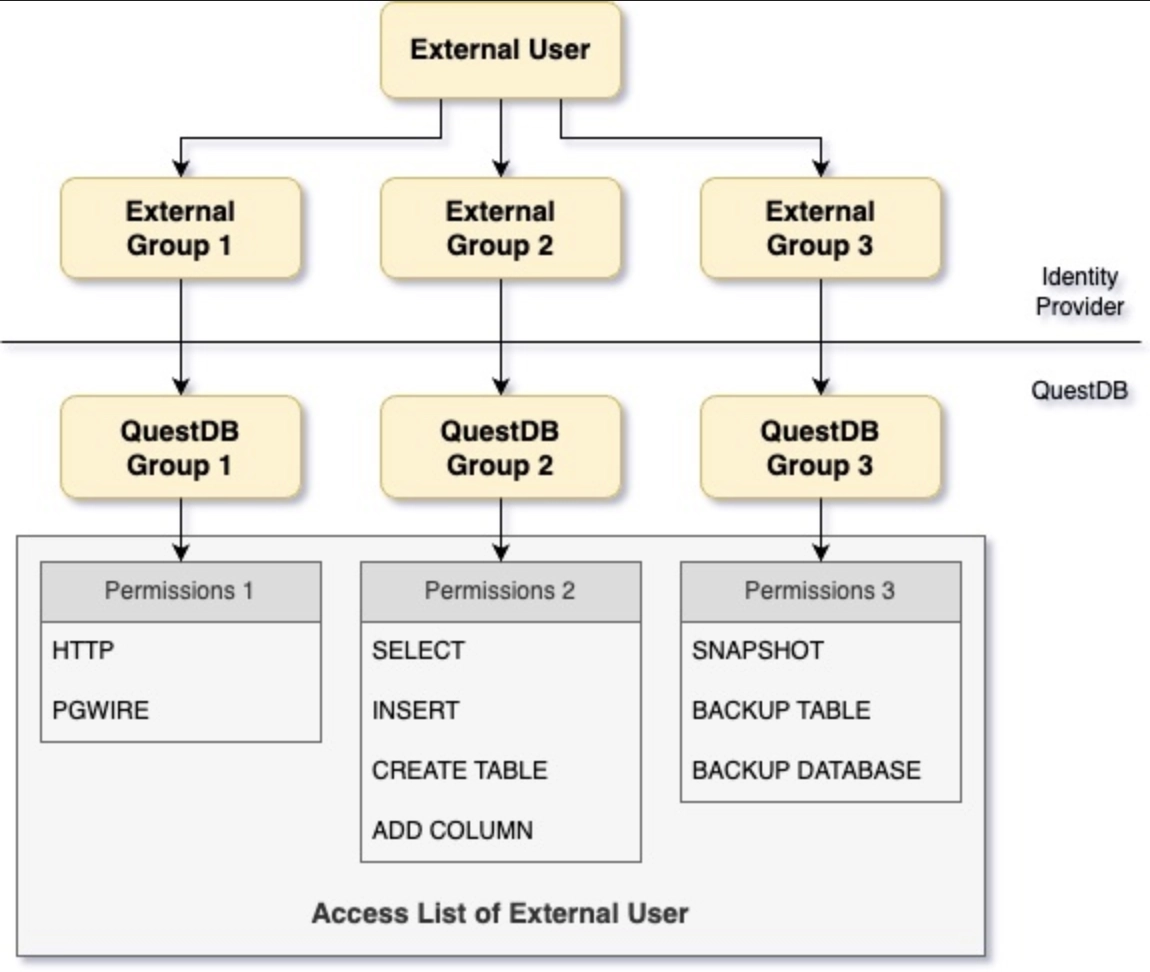
Mapping user permissions
The mappings between external and QuestDB groups are managed with the following SQL commands:
CREATE GROUP groupName WITH EXTERNAL ALIAS 'CN=TestGroup1,OU=DC Users,DC=ad,DC=quest,DC=dev';
ALTER GROUP groupName WITH EXTERNAL ALIAS 'CN=TestGroup1,OU=DC Users,DC=ad,DC=quest,DC=dev';
ALTER GROUP groupName DROP EXTERNAL ALIAS 'CN=TestGroup1,OU=DC Users,DC=ad,DC=quest,DC=dev';
QuestDB works the list of external groups out from the User Info response message.
If we take the example used earlier, we will see that the message contains a
claim called groups. This name is configurable in QuestDB.
If the groups claim is missing or it is an empty list, the user cannot access the database.
Although the user is authenticated, they have no permissions at all.
The user has to have at least the HTTP permission to be able to successfully
login via the Web Console.
{
"sub": "externalUser",
"name": "External User",
"groups": [
"CN=TestGroup1,OU=DC Users,DC=ad,DC=quest,DC=dev",
"CN=TestGroup2,OU=DC Users,DC=ad,DC=quest,DC=dev"
]
}
Any change made to the user's group membership in the Identity Provider, QuestDB will adjust the user's access list.
There may be a slight delay due to the User Info Cache.
QuestDB will use the cached information until it becomes stale, and gets updated.
The same stands for changes made to the user's status within the Identity Provider.
For example, a disabled user will not be kicked out of QuestDB immediately.
The acl.oidc.cache.ttl config option drives how often user information should
be synchronized with the Identity Providers.
It should be set accordingly to your organization's policies.
Other parts of the user information, such as the sub and the name also used
by QuestDB.
They could be displayed in the Web Console, or appear in the logs, for example.
Configuration options
For all OIDC-related configuration options of QuestDB, see Configuration.
Active Directory
The following sections are guides for setting up single sign-on (SSO) with various OAuth2 providers.
PingFederate
This document helps set up SSO authentication for the Web Console in PingFederate.
It is assumed that the Azure Active Directory serves as the Identity Provider (IdP).
Set up PingFederate client
First thing first, let's pick a name for the client!

The QuestDB Web Console is a SPA (Single Page App).
As a result, it cannot store safely a client secret.
Instead it can use PKCE (Proof Key for Code Exchange) to secure the flow.
As shown above, leave the client authentication disabled.
We also have to white list the URL of the Web Console as a redirection URL:

We can instruct PingFederate to automatically authorize the scopes requested by the Web Console.
The user will not be presented the extra window asking for consent after authentication:

The Web Console uses the Authorization Code Flow, and refreshes tokens automatically.
Next, enable the grant types required for this flow:

We've selected:
- Authorization Code
- Refresh Token
- Access Token Validation (Client is a Resource Server)
After that, select the token manager for the client.
The token manager is responsible for issuing access tokens.
All token related settings should be configured in the token manager.

Finally, enable PKCE - as shown above - and save the settings.
Access Token Manager settings
QuestDB does not require any special setup regarding the access token.
We recommend that you do not to use shorter tokens than the default 28 characters.
As the QuestDB Web Console refreshes the token automatically, there is no need for long-lived tokens:

We've selected:
- Token length: 28
- Token lifetime: 5
- Lifetime extension policy: None
- Maximum token lifetime: Null
- Lifetime extension threshold percentage: 30
For the next step, we tune the Authorization Server.
Authorization Server settings
These settings relate to the authorization code, refresh token and CORS.

In this section, we've entered:
- Authorization code timeout: 60
- Authorization code entropy: 30
- Client secret retention period: 0
Next, ensure the ROLL REFRESH TOKEN VALUES option is selected:

It is also important to whitelist the Web Console's URL on the CORS list:

Set up a Microsoft Entra ID Data Source
PingFederate needs a Data Source setup.
This is a secure LDAP connection to Microsoft Entra ID, formerly known as Azure Active Directory.
The data source needs a:
- name
- hostname
- port
- username and password for the LDAP connection

We have given it the name EntraDS and it will be applied later.
Set up a Password Credential Validator
Now that PingFederate has an LDAP connection, we can use it for authentication.
First, create a Password Credential Validator:

We've entered:
- Instance name: EntraPCV
- Instance ID: EntraPCV
- Selected: LDAP Username Password Credential Validator
- Parent instance: None
Furthermore, we now declare our previously created data source (EntraDS):

This links our data store (EntraDS) to our PCV (EntraPCV).
Set up an Identity Provider
We can use our PCV once we set up an Identity Provider.
The IdP will be used to authenticate users against Active Directory using the LDAP connection.
We do this in the Type subsection:

Next, in the IdP Adapter section...
Click: Add a new row to Credential Validators.
Select the PCV (EntraPCV) we created.
Optionally alter number of retries:

Add groups to OIDC policy management
QuestDB now needs to know about the user's AD group memberships to find their permissions.
Groups are passed to QuestDB inside the User Info object in a custom claim.
This has to be added in the OpenID Connect Policy Management.
The field is Multi-Valued, because it is a list of group names.
Under the Attribute Contract subsection, see:

Next, click to the Attribute Scopes subsection.
Ensure groups is among the openid attributes:

Onwards to the Attribute Sources & User Lookup Section.
From this view, you can add local data stores.
Note item test of type of LDAP:

We created it via the following choices in Add Attribute Source:

Note where we specified the Data Store (EntraDS).
This is also where the directory search parameters are defined.
Back at the Attribute Sources & User Lookup Section section, note we have set
email.
The source is LDAP (test), while the value is usePrincipalName:

And finally!
In the same Attribute Sources & User Lookup Section...
Find groups.
Note the definition of Source (LDAP (test)) that bridges our various parts.
The value is memberOf.

Enable Resource Owner Password Credentials (ROPC) flow
As described in the
OIDC operations document
tools - such as psql - can be integrated with the OIDC provider using the ROPC flow.
When setting this flow up, enable the Resource Owner Password Credentials flow in the client settings.
Next, create a Resource Owner Credentials Grant Mapping to map values obtained from the Password Credential Validator (PCV) into the persistent grants.
When setting this up, select the previously created LDAP Data Source and IdP Adapter, which links to the existing PCV.
Then select the username attribute of the PCV as USER_KEY.
Confirm QuestDB mappings and login
QuestDB requires a mapping, as laid out in the OIDC operations document.
If a given user has the HTTP permission, they will be able to now login via the Web Console.
To test, head to http://localhost:9000 and login.
If all has been wired up well, then login will succeed.
Microsoft EntraId
This document sets up SSO authentication for the QuestDB Web Console in Microsoft EntraID, formerly known as Azure AD.
To enlarge the images, click or tap them.
Set up the client application in Entra ID
First thing first, let's pick a name for the client!
Then head to Microsoft Entra Admin Center, and register the application under Identity - App registrations - New registration.
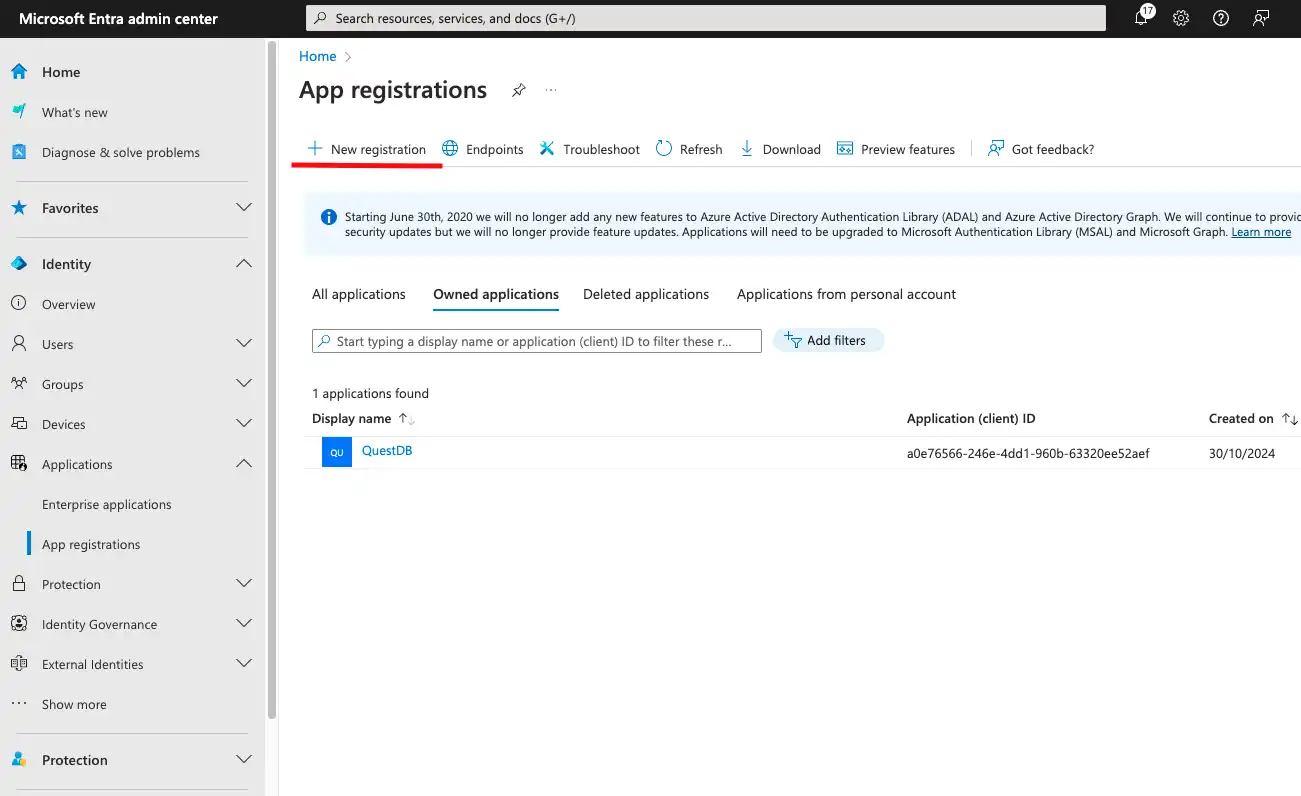
The QuestDB Web Console is a SPA (Single Page App).
As a result, it cannot store safely a client secret.
Instead, it can use PKCE (Proof Key for Code Exchange) to secure the flow.
When registering the application, select the SPA platform.
We also have to specify the URL of the Web Console as Redirect URI.

After clicking Register, we have created a client application with the name QuestDB.
Each application is assigned a unique id (known as Client ID in the OAuth2 - OIDC standard). The client will identify itself with this id when sending requests to Entra ID.
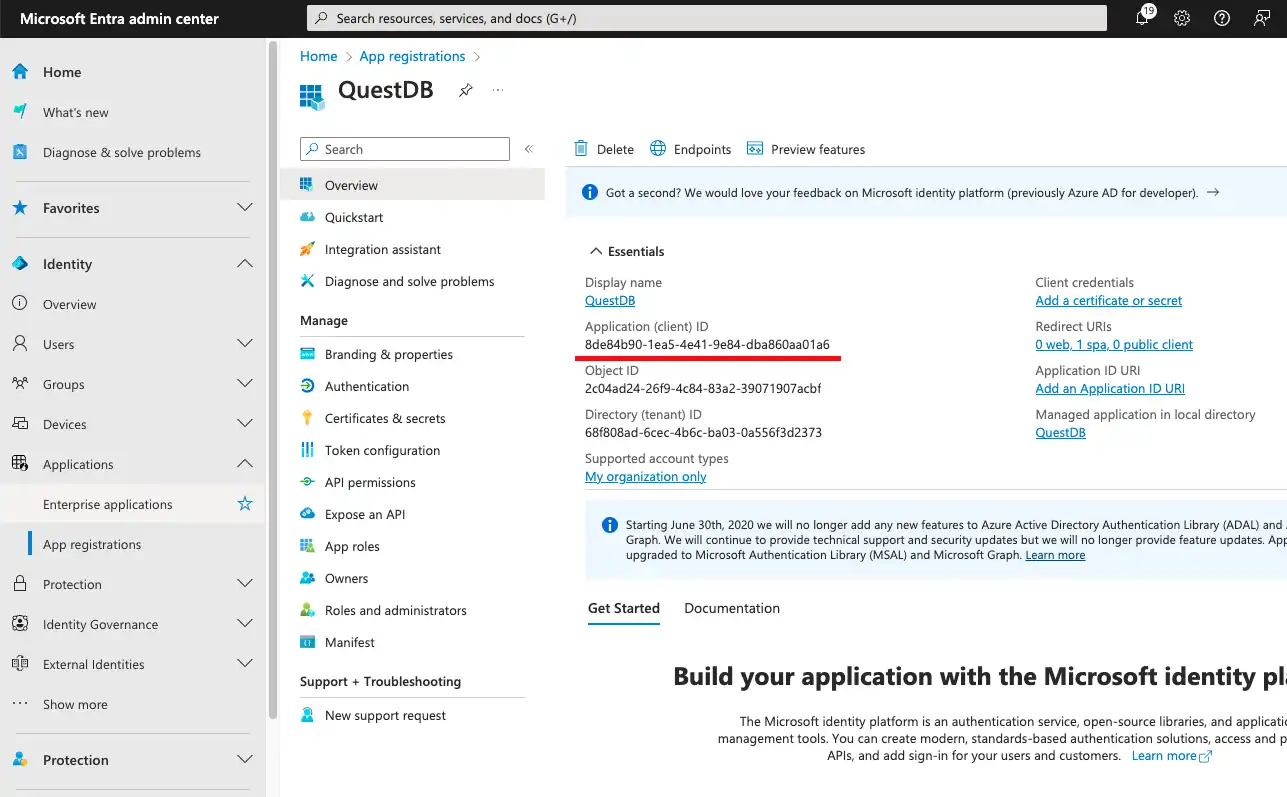
We find the platform configurations under Authentication. This is the place where the previously set redirect URI can be viewed and modified. We can also specify additional redirect URIs, if necessary.
The redirect URIs of the application are automatically eligible for the Authorization Code Flow with PKCE, which is a special version of the OAuth2 standard's Authorization Code Flow. It is specifically designed for applications where a client secret (e.g. a password) could not be kept safely. As single page applications run in the browser, they fall into this category.
The redirect URIs are also added to the CORS (Cross-Origin Resource Sharing) policy of EntraID. CORS is a mechanism to allow a web page, such as the Web Console, to access resources from a different domain than the one that served the page. In this context this means that we let the Web Console to access Entra ID, while its origin is the HTTP endpoint of QuestDB.
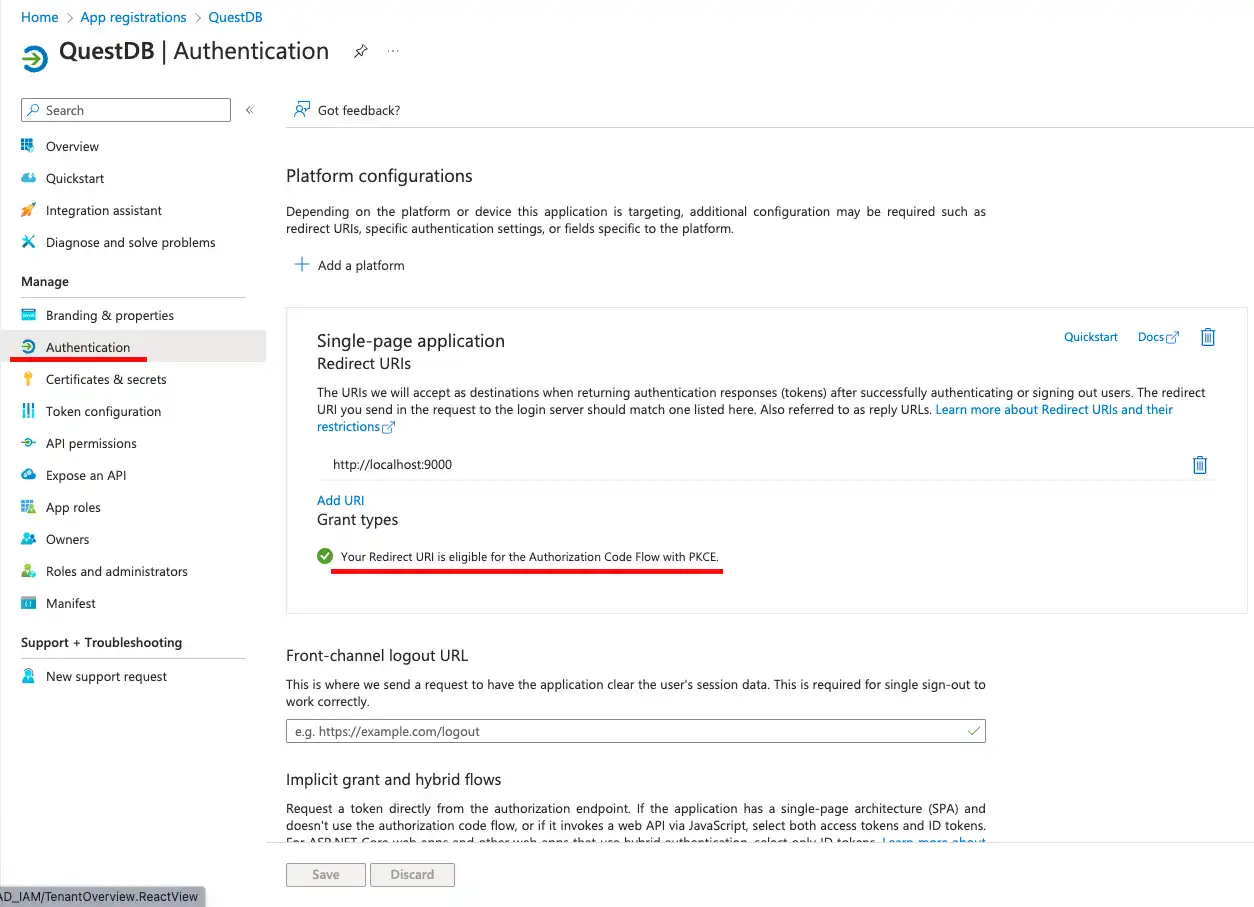
If we scroll down to the bottom of this page, we can also find a section where we can enable the Resource Owner Password Credential Flow.
This OAuth2 flow is legacy, and should be enabled only if there is a requirement of connecting to QuestDB using SSO (Single Sign-On) via clients not supporting redirect based web flows. This could mean a Postgres client without OAuth2 integration, such as psql, or a standalone in-house client application, or could be just a jupyter notebook.
The main issue with this flow is that the client application has to be trusted with the user's login details. The user's credentials are passed to the application, in this case to QuestDB, and the client application uses these credentials to authenticate the user by forwarding them to the identity provider, in this case to Entra ID.
It is guaranteed that QuestDB does not store the user's credentials in any way. They are not persisted into the database, not even in encrypted form. The login details are treated as passthrough information. Only exception is that server logs can contain the username, logged for audit purposes.

Our next stop is the Token configuration, where the OAuth2/OIDC access and ID tokens can be customized.
Note that users can be authenticated without customized tokens, but authorization would prove to be challenging. The user's security groups are not included in the tokens by default.
QuestDB can be configured to request the user's groups from the UserInfo endpoint of the OAuth2 server, but Entra ID cannot be configured to provide this information via the UserInfo endpoint. Therefore, we choose to customize the tokens, QuestDB will decode and validate the ID token, and take the group information from there.
QuestDB authorization relies on receiving the group memberships of the user. Entra ID groups should be mapped to QuestDB groups, and permissions can be granted to the QuestDB groups. Detailed information about group mappings can be found in the OIDC integration documentation.

The customized tokens contain user information which cannot be accessed without permission. User information is provided by Microsoft Graph, so the client application needs specific permissions to access Microsoft Graph APIs.
These permissions can be configured under API permissions. It is important to note that we will be setting Delegated permissions here, meaning we are not granting actual permissions to access user data. Instead, each user logging into QuestDB will have to consent to accessing their user profile.
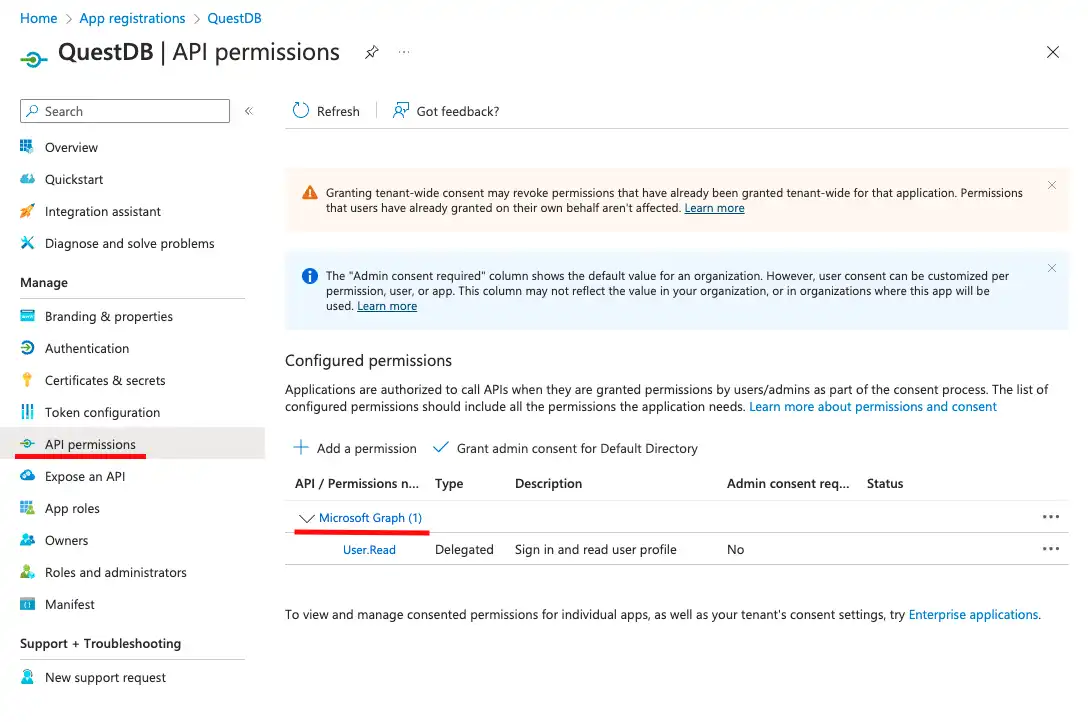
By default, the User.Read permission is added to the list, but what we really need is:
- openid: to be able to issue ID tokens
- profile: to access user information
- offline_access: to be able to issue refresh tokens
By clicking on Microsoft Graph we can select and add these permissions.
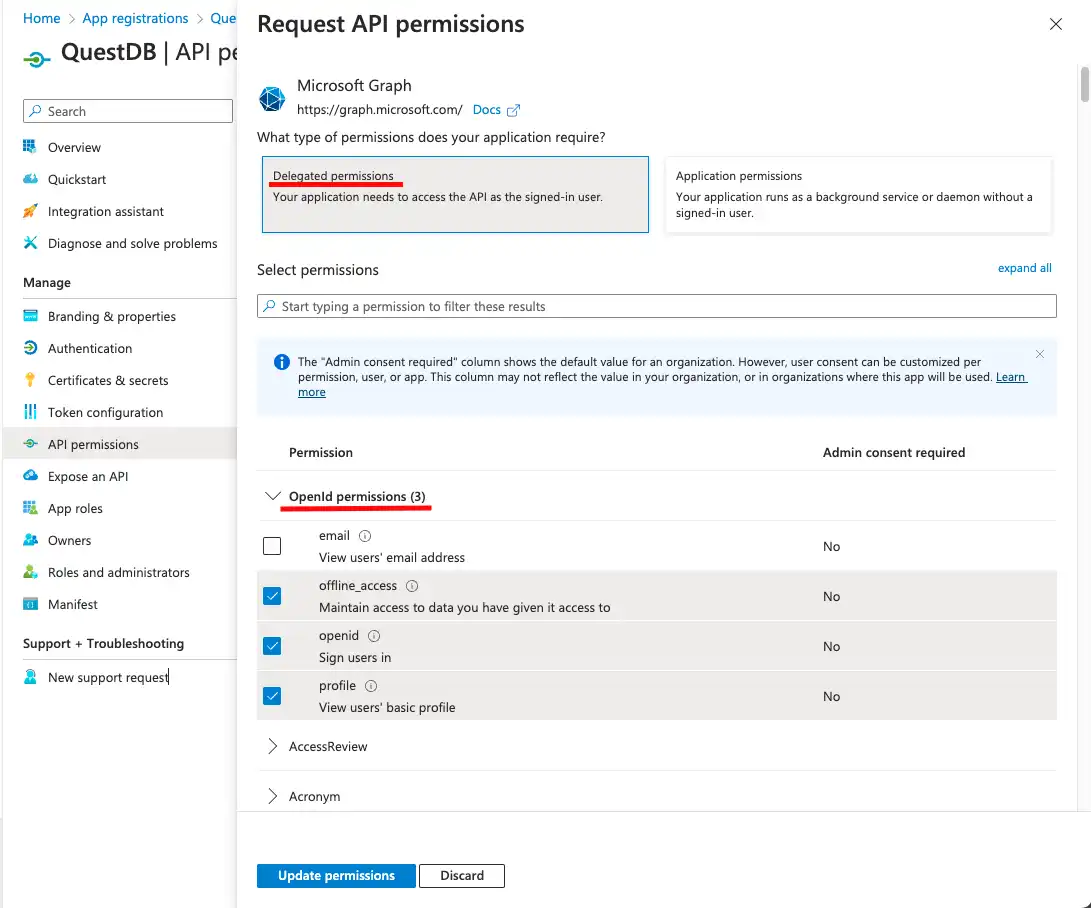
The User.Read permission is not needed. It can be removed by clicking
on the ... at the end of the row, and selecting Remove permission from
the popup menu.
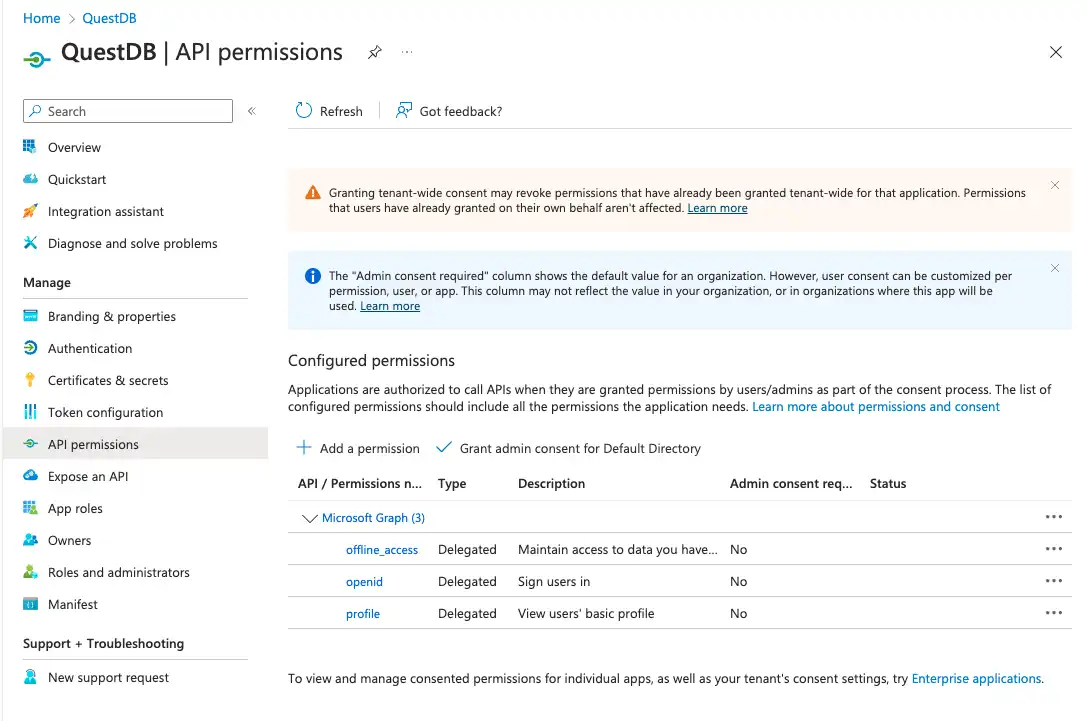
With this we have finished setting up the QuestDB client application in Entra ID, and now we can wire QuestDB and Entra ID together by adding OIDC configuration to QuestDB.
QuestDB configuration
The below should be set in QuestDB's server.conf:
# enable OIDC
acl.oidc.enabled=true
# the claim contains the username or user id
acl.oidc.sub.claim=name
# the claim contains the user's group memberships
acl.oidc.groups.claim=groups
# groups are encoded in the token
acl.oidc.groups.encoded.in.token=true
# OIDC configuration endpoint of Entra ID
acl.oidc.configuration.url=https://login.microsoftonline.com/12345678-1234-1234-1234-123456789abc/v2.0/.well-known/openid-configuration
# application ID taken from Entra ID
acl.oidc.client.id=8de84b90-1ea5-4e41-9e84-dba860aa01a6
# redirect URI, QuestDB's HTTP endpoint
acl.oidc.redirect.uri=http://localhost:9000
# OAuth scopes the user has to consent to
acl.oidc.scope=openid profile offline_access
# enable ROPC flow
# optional, required only if ROPC is enabled in Entra ID
acl.oidc.ropc.flow.enabled=true
The application ID and the OIDC configuration endpoint's URL can be found in the Overview of the application in Entra ID.
The application ID is displayed right under the application's name, the OIDC configuration endpoint is displayed on the panel which opens up when the Endpoints button is clicked.
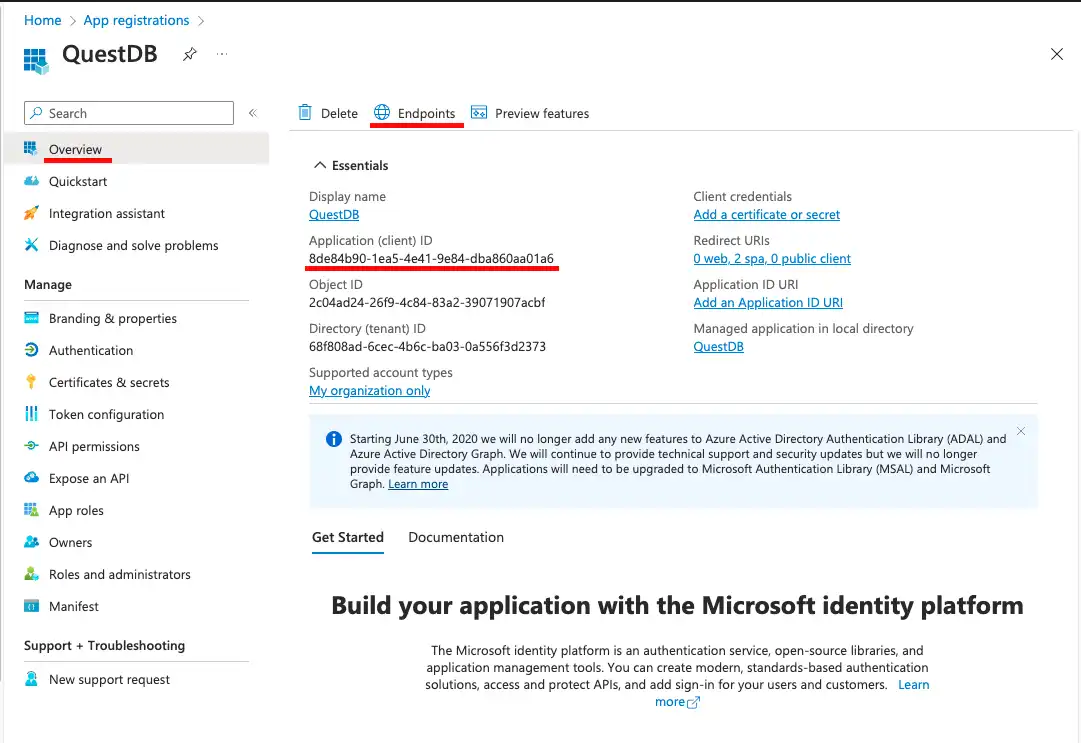
Map groups and grant permissions
Now we can start QuestDB, and login with the built-in admin to create group mappings.
As mentioned earlier, authorization works by mapping Entra ID groups to QuestDB groups. When the user logs in, QuestDB decodes Entra ID group memberships from the token, then finds the QuestDB groups mapped to them, and the user gets the permissions based on the mapped groups.
CREATE GROUP extUsers WITH EXTERNAL ALIAS '87654321-1234-1234-1234-123456789abc';
The above command maps the Entra ID group identified by object
id 87654321-1234-1234-1234-123456789abc to a QuestDB group called extUsers.
We should grant the necessary QuestDB endpoint permissions first to make sure users can access the Web Console, Postgres and ILP interfaces as required. Read more about endpoint permissions.
GRANT HTTP, PGWIRE TO groupName;
Now we can grant the rest of the permissions as required. We can grant access to tables, for example.
GRANT SELECT ON table1, table2 to groupName;
Confirm group mappings and login
To test, head to the Web Console and login.
If all has been wired up well, then login will succeed, and the user will have the access granted to them.